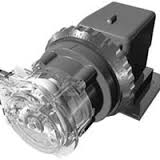Lowering the pH of Water in the Home
by Gene Franks
Stenner Peristaltic Pump
High pH in home water is treated far less frequently than low pH. In general, there are few negatives to high pH, but it can produce a soda taste and even cause corrosion in piping and fixtures made with metals such as brass, copper, zinc, aluminum and iron. Very high pH can also cause chlorination to be ineffective.
High pH can be reduced with specialized ion exchange media, but the most common treatment is to inject a mild acid into the water line. It is normally a “point-of-entry” treatment.
With wells, the normal place to inject the acid is just before the pressure tank.
To inject you need a chemical feed pump made of materials that resist corrosion (plastic, in other words) and a solution tank to hold the acid. The most commonly used acid for pH reduction is acetic acid, which is plain old supermarket grade white vinegar. It is safe, effective, economical, and readily available. Acetic acid is usually injected in about a five percent solution. Other popular weak acids available to residential users are citric acid, a bit stronger than vinegar, which is fed in a one percent solution, sodium bisulfate (potable water grade), fed at one percent, and alum, fed in a two-percent solution.
Hydrochloric and sulfuric acids are usually used only with industrial applications and in cases where alkalinity is extremely high.
As with most treatments in which a solution is fed into a water line, pH reduction will involve some trial and error. I suggest that you start with the solution strengths given above, set your pump at its medium setting, and give it a try. Check the pH downstream of the feed (but before any water treatment equipment) after a couple of days and adjust your solution strength or pump setting as needed.





